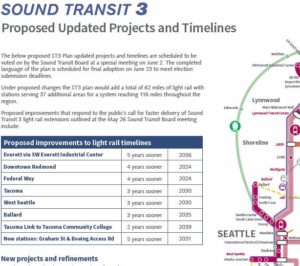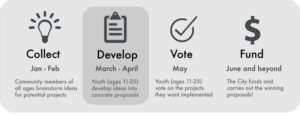Revised ST3 Plan: Light Rail to West Seattle Three Years Sooner! 2035 Comprehensive Planning Update and Displacement Risk Analysis; Your Voice, Youth Choice–vote online now or at South Park Community Center tomorrow; June 10th Office Hours; 100,000 Opportunities Initiative
Revised ST3 Plan: Light Rail to West Seattle Three Years Sooner!
The Sound Transit Board has announced a revised ST3 plan that reduces, by three years, the projected timeline to bring light rail to West Seattle.
The revised plan also accelerates light rail to Ballard by three years, adds a new station to the existing line at South Graham Street five years sooner, and provides funding for completion of a station at NE 130th Street.
The updated projects and timelines are available at the ST3 document library. 
Earlier this week the City Council passed a resolution encouraging Sound Transit to accelerate the schedule and provide ST3 transit service as quickly as possible.
Many thanks to the leadership of Board Chair Dow Constantine, my Council colleague and Board Member Rob Johnson, and Councilmember Mike O’Brien for his collaborative work in developing the Council resolution.
The Sound Transit Board is expected to take final action to send the ST3 package to the General Election ballot next month.
2035 Comprehensive Planning update and the Displacement Risk Analysis
On May 3, the Mayor released his proposed 20-year update to the Seattle Comprehensive Plan. CompPlan 2035. The Comprehensive Plan is the City’s core policy and planning document for land use, transportation and housing. In addition, the Mayor on Monday released a draft Equitable Development Implementation Plan.
A key issue for me during this comprehensive planning process is commit to meaningfully addressing displacement. The City anticipates that by 2035 the city will have 120,000 more people, 70,000 more housing units and 115,000 more jobs. We cannot ensure equitable growth without intentionally addressing displacement.
In 2015, former Councilmember Licata and Councilmember O’Brien worked hard to ensure that the office of Department of Planning and Development (DPD) defined displacement and conducted a displacement risk analysis for the 4 Comp Plan alternatives being considered at that time. Here is the definition of displacement:
The involuntary relocation of current residents or businesses from their current residence. This is a different phenomenon than when property owners voluntarily sell their interests to capture an increase in value. This analysis addresses both physical (direct) and economic displacement (indirect) displacement. Physical displacement is the result of eviction, acquisition, rehabilitation, or demolition of property, or the expiration
of covenants on rent- or income-restricted housing. Economic displacement occurs when residents and businesses can no longer afford escalating rents or property taxes. Cultural displacement occurs when people choose to move because their neighbors and culturally related businesses have left the area.
Here is how the Displacement Risk Analysis was done for those four alternatives, the result being a CompPlan recommendation that includes strategies to mitigate displacement, in this case the above mentioned Equitable Development Implementation Plan.
 This was an important step forward, but the commitment to doing this work must be ongoing, not one time, for one plan.
This was an important step forward, but the commitment to doing this work must be ongoing, not one time, for one plan.
I’m pleased to learn that the Executive has proposed two additional policies to the Comp Plan that will ensure we are using the displacement risk analysis as a tool on ongoing land use decisions:
The proposed policies the following: (1) LU 2.7 Review future legislative rezones to determine if they pose a risk of increasing the displacement of residents, especially marginalized populations, and the businesses and institutions that serve them. (2) LU 2.8 Evaluate new land use regulations to determine if there are potential adverse outcomes that may affect marginalized populations or other groups or individuals unfairly, and seek to avoid or mitigate such potential outcomes.
What is a Displacement Risk Analysis exactly? It looks at the extent to which zoning changes would result in displacement or fragmentation of existing businesses and existing residents, including people living with poverty, families with children, and intergenerational households or cultural groups within the area. The analysis seeks to answer the following questions:
- Is the intensity of expected growth in particular urban centers and villages likely to have an impact on displacement of marginalized populations?
- Is the intensity of expected growth in particular urban centers and villages likely to have an impact on marginalized populations’ access to key determinants of physical, social, and economic well-being?
- What strategies and levels of investment are necessary to mitigate the impacts of expected growth and to maximize opportunities for equitable outcomes?
I look forward to proposing legislation that will implement these two policies.
Over the next several months, the Council will be reviewing the Mayor’s recommended CompPlan 2035. Given the breadth of topics covered by the Plan each topic will be heard in the committee that oversees that issue. This will help us have a deeper conversation about the issues in these elements most pertinent to each committee.
| Date and Time | Committee | Topics |
| June 7, 9:30am | PLUZ Committee | Growth Strategy, Land Use Element and the Future Land Use Map |
| June 21, 2:00pm | Sustainability & Transportation | Transportation Element |
| July 6, 9:30am | AHNF | Housing and Neighborhood Planning Elements |
| July 12, 9:30am | CRUEDA | Capital Facilities, Economic Development, and Arts and Culture Elements |
| July 12, 2:00pm | Energy & Environment | Environmental implications and Utilities Element |
| July 13, 2:00pm | Human Services & Public Health | Community Well-Being Element |
| July 20, 2:00pm | Education Equity & Governance | Schools & Growth |
| July 21, 9:30am | PSCLW | Parks & Open Space Element |
| August 2, 9:30AM | PLUZ | Start to discuss amendments |
Youth Voice, Youth Choice—vote now online OR at South Park Community Center tomorrow!
Young people between age 11 and 25 have until May 29 to vote on how to spend $700,000 of the city budget, either online or in person.
The options were developed as part of the Youth Voice, Youth Choice Participatory Budgeting project, run through the Department of Neighborhoods.
If you are between 11 and 25, you can vote for your top 7 projects out of 19 total proposals, developed by city youth from over 530 project ideas submitted citywide. The projects with the most votes will be funded by the City.
Youth also developed the rulebook for running the process; the Seattle Channel has a short video with more background.
Youth age 13-25 can vote online here; 11 and 12 year olds must vote in person; in-person voting is open to 13-25 year olds as well. The South Park Community Center will be open to cast votes on Saturday, May 28, from 12:00 noon – 4:00 p.m. It’s located at 8319 8th Ave South.
June 10th Office Hours
Please join me at my upcoming office hours. I will be at the South Park Community Center (8319 8th Avenue S) on June 10th from 12:00pm to 7:00pm. These are walk-in friendly, but if you would like to let me know you’re come please email my scheduler Alex Clardy (alex.clardy@seattle.gov).
100,000 Opportunities Initiative
On May 5th a coalition of 28 companies including Starbucks, Microsoft, Alaska Airlines, and Nordstrom held an opportunity fair for youth at CenturyLink Event Center. Attendees were able to access career development, education opportunities, civic engagement, and legal resources. In total 1,500 youth and 300 parents, caseworkers, and other caregivers attended the Fair. More than 1,300 interviews were conducted and coalition companies gave 700 on the spot job offers.
Here are some additional results from the Fair:
- Hundreds of youth worked on their resumes, completed job applications, and received interview coaching with the support of experts
- 500+ youth received coaching on professional wear and clothing from Nordstrom, Goodwill, and Macy’s
- 300 youth got headshots and created new LinkedIn profiles
- 100+ youth registered to vote, learned about banking and financial resources, explored high school re-engagement, took a food handling class/passed the food handler permit test/and got a their permit!
Posted: May 27th, 2016 under Councilmember Herbold, District 1, District Office Hours, Education, Housing, Libraries, Parks and Recreation, Planning and Land Use, Public Health, Sound Transit, Transportation
Tags: 2035, displacement, Sound Transit, South Park, West Seattle


